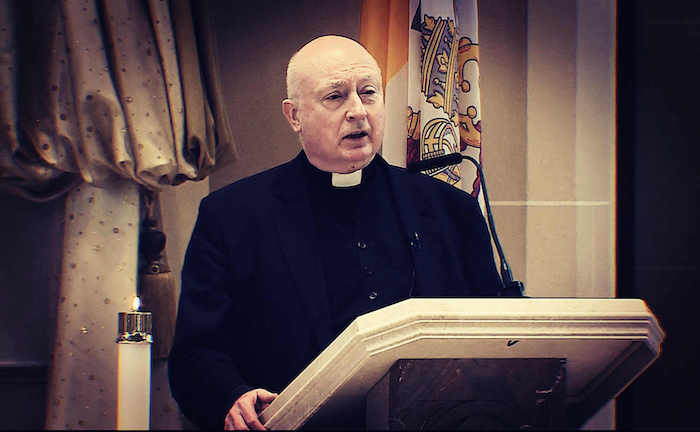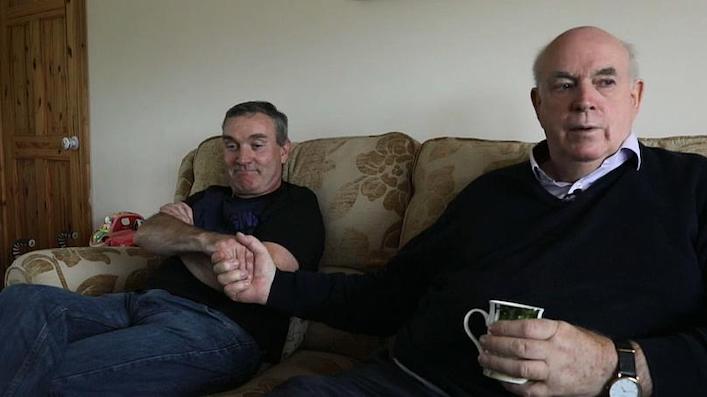— Church must confront, change old boys’ network exposed in Vatican’s McCarrick report

The report refers to her simply as “Mother 1.”
A Manhattan woman with a large brood of mostly boys and an Irish husband, she had become suspicious of then-New York Monsignor Theodore McCarrick, who snaked his way into her family and had her children call him “Uncle Ted.’’
Her husband thought it an honor to have a clergyman take an interest in his children. Mother 1, not so.
Her antennae went up when she learned McCarrick gave her sons alcohol when he took them on trips. He continued to visit even after moving to New Jersey, and, one day, she came home to find McCarrick sitting on the couch with a son on either side of him and a hand on the thigh of each.
By then, it was the early 1980s. She took it upon herself to mail identical anonymous letters accusing McCarrick of abuse to every cardinal in the United States and to the Apostolic Nuncio in Washington, D.C.
Nothing changed.
“It’s a club of men who all knew about it and had ignored it,” Mother 1 concluded nearly 40 years later in one of three interviews she gave to an investigator working for the Vatican.
She was right.
MASTER MANIPULATOR
Having been ordained in his native New York in 1958, Theodore Edgar McCarrick rose to be an auxiliary bishop there, then crossed the river as the first bishop of the New Jersey’s Metuchen Diocese from 1981-86. He then served as archbishop of the Newark Archdiocese for 14 years before moving to the Washington, D.C., archdiocese and becoming a cardinal.
In all that time, we now know, complaints and rumors of abuse by him fell on deaf ears.
I was among the priests in the Archdiocese of Newark who thought McCarrick’s drippy piety was synthetic. One of our most respected monsignors called him “slippery.”
He was, in fact, a master manipulator who gamed the Catholic system for one goal: to get the red hat of a cardinal, which he did.
The 449-page Vatican “Report on the Holy See’s Institutional Knowledge and Decision-Making Related to Former Cardinal Theodore Edgar McCarrick (1930-2017),’’ released Nov. 10 and carrying 1, 400 footnotes, chronicles his rise and demise once credible accusations of sexual abuse of minors surfaced.
Thorough and meticulous in detail, the report includes many salacious details that wouldn’t be expected from something commissioned by the Vatican. It indicts the clerical system – meaning an all-male leadership – but it doesn’t address what the future might hold.
After reading it, I differ on some of the conclusions drawn by other commentators.
SHOW US THE MONEY TRAIL
Most conspicuously absent from the report’s pages is the money trail.
While it asserts that McCarrick was a prodigious fund-raiser and a natural money man, it falls short of showing how he used the largesse of others to ascend the hierarchy, escape scrutiny and still become a cardinal.
“Overall, the record appears to show that although McCarrick’s fundraising skills were weighed heavily, they were not determinative with respect to major decisions made relating to McCarrick,” wrote U.S. lawyer Jeffrey Lena, who investigated him and authored the report.
“In addition, the examination did not reveal evidence that McCarrick’s customary gift-giving and donations impacted significant decisions made by the Holy See regarding McCarrick during any period,” Lena wrote.
But the report fails to account for why so many members of the hierarchy failed to take evidence of alleged abuse seriously and investigate and, at best, stop him in his tracks.
Later the report stated: “McCarrick began in earnest his customary gift giving to Roman Curia and Nunciature officials, a practice that continued through 2017
The Vatican should reveal these gifts, show us the money trail and hold anyone swayed by money over duty responsible. Otherwise, the Vatican continues to be one of the enablers.
THREE POPES
In my view, three popes have unfairly come under attack for giving McCarrick a pass. Francis took heat, especially from the former apostolic nuncio to the U.S., Archbishop Carlo Vigano, for failing to reign in McCarrick.
But the report shows that once definite proof surfaced in June 2017 that McCarrick sexually assaulted children from the time he was a priest of the Archdiocese of New York, Francis removed him from the College of Cardinals and eventually defrocked him, removing him from the clerical state and making him a layman. (It’s unknown where McCarrick, now 90, lives although it’s been reported he’s in Florida.)
The report does implicate the late Pope John Paul II for promoting McCarrick to become the archbishop of Washington, D.C., in 2000 when rumors of his sexual abuse of seminarians and priests — from his time as the first bishop of Metuchen starting in 1981 — were an open secret.
I think this accusation is a stretch since John Paul’s Parkinson’s had evidently debilitated him and he relied on advice from his staff and other members of his curia, who clearly ignored numerous red flags that surfaced.
Pope Benedict XVI made McCarrick retire from the D.C. post in 2006, after he’d turned 75, and did not allow him to stay the usual several years more, which is common for most cardinals. He also imposed loose voluntary measures for McCarrick to keep a low profile and tone down his travels and media presence, which McCarrick flouted.
Even papal warnings did not deter McCarrick from the high life, according to the report.
GLOBETROTTER
Up until his mid-80s, McCarrick must have traveled the globe a hundred times.
As archbishop of Newark, he would publish scores of letters sent to the priests recounting his global stops, famous people he met and tireless work for the church. McCarrick had a knack of blowing his own horn to make himself appear more important than he really was.
The report notes that the late John Cardinal O’Connor, though, put a kibosh on that. Perhaps jealous that McCarrick was poaching his big New York donors for the Papal Foundation, which would later on contribute to McCarrick’s red hat, O’Connor called out McCarrick’s alleged sexual abuses in a 1999 letter to the Apostolic Nuncio in D.C. and said he did not want McCarrick to succeed him.
Other members of the hierarchy saw the letter without confirming it ever got to John Paul.
But, as the report says, McCarrick had been buttering up John Paul and especially his personal secretary, now-retired Cardinal Stanisław Dziwisz, since he was a New York priest and he pulled out all the stops to become archbishop of Washington, D.C.
‘BLIND OBEDIENCE’
The report does show failures by several now-deceased New Jersey bishops to stop McCarrick, thus allowing him to continue to abuse. Had his Metuchen successor Edward Hughes, for example, followed up on first-hand testimony from seminarians that he sexually abused them, McCarrick might have gone nowhere.
“He did not want to accept that there was sex abuse in the church, much less by a bishop,’’ an unidentified priest of Metuchen told the investigator. “And, as holy a man as he was, he was also a person who believed that nearly blind obedience to bishops was a foundational principle. So, dealing with an issue like this with regard to the archbishop of Newark would have opened a real crack in that foundation. It was not something that this man was ready to do.”
Back then, the only bishop who stood up to McCarrick was James McHugh, a Newark priest who became Bishop of Camden and is now deceased. The report states that he alerted the D.C. nuncio that McCarrick would take seminarians to a Sea Girt shore house and share a bed with them.
Soon after, the house was sold.
ACCOMPLICES?
Sadly, the report adds a footnote that McCarrick priest secretaries, almost 30 from Newark alone, had amnesia about McCarrick’s trysts. Nor is there any evidence that seminary rectors, faculty and even bishops from New Jersey and New York were even interviewed or cited in the report.
McCarrick did not get away with this all by himself. He had willing accomplices who did his bidding blindly.
The report cites a chilling conclusion from a 2019 Seton Hall University investigation, not previously released to the public:
“McCarrick created a culture of fear and intimidation that supported his personal objectives. McCarrick used his position of power as then-archbishop of Newark to sexually harass seminarians.”
‘OLD BOYS’ NETWORK’
Another shortcoming of the investigation is that only a handful of women are mentioned in the voluminous report.
Mother Mary Quentin, superior general of a Michigan order of nuns, is named for reporting to the D.C. nuncio in 1994 that she learned that McCarrick abused a priest. The report quotes that the nuncio dismissed her with a snide comment, “She wanted to make herself appear important.”
Calling out the Catholic church’s misogyny, I believe, is a needed prelude to exposing how the clerical system protected McCarrick and allowed him to become a cardinal.
This report also indicts the secretive system of selecting and promoting bishops.
What is needed is “truth telling,” Chestnut Hill Josephite Sister Catherine Nerney told me in a telephone interview.
“The church has not really been upfront and that needs to happen,” said Nerney, a professor of theology and founding director of the Institute of Forgiveness and Reconciliation at Chestnut Hill College in Philadelphia.
‘CONFONT THE EVIL’
After spending time in Rwanda in 2006 to learn how the country tried to heal from the four-month 1994 civil war that took the lives of almost one million citizens, she learned, she said, that the first thing to do in an overwhelming crisis is to “confront the evil
In Rwanda, small groups came together “for the good of society,” she said, to confront the killers.
Comparing the McCarrick report to that process, Nerney said: “The church has hidden so much that it is complicit and corrupt behind its clerical status.”
In other words, clericalism puts an all-male clergy on a pedestal and uses secrecy to handle its own dirty laundry, so to speak, so it can protect its male members.
Back on Sept. 14, 2018. Cardinal Joseph W. Tobin led the Archdiocese of Newark in an evening service of Prayer, Reconciliation and Hope in the Cathedral Basilica of the Sacred Heart. Hundreds of clergy, religious and laypeople prayed for the survivors of clergy abuse, their families, the accused, and the church.
One abuse survivor preached quite candidly about what a priest did to him. Some priests pushed back, and two subsequent services decreased in attendance and then stopped.
WILL ANY GOOD COME OF IT?
So, where do we go from here?
Since the McCarrick report was released, nothing has been said about any follow-up by the Vatican or any of the local dioceses where McCarrick served as a bishop. And while the release of the report was historic, this failure is a disappointment.
The church needs to report now what it will do to prevent another McCarrick from abusing with impunity – even being promoted to the highest offices as he was — and what protocols will be put in place
First, the process for selecting priests to become bishops and promoting a bishop to become a diocesan bishop needs to become transparent.
Complete Article ↪HERE↩!




